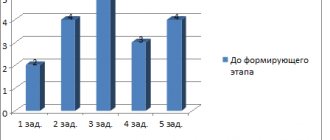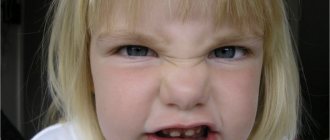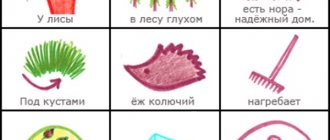Alysh remembers what he heard, so incorrect pronunciation, baby talk, dialects, and filler words are remembered very quickly. And as you know, retraining is more difficult than teaching. A preschool child will speak correctly when he hears correct literary speech. What are the components of speech? This is expressed in the table as follows:
| Speech development is | |||
| Formation of a dictionary | Grammatical structure | Sound culture | Connected speech |
The level of speech development is determined through a diagnostic examination of preschool children.
Diagnostics of speech development of children 2-4 years old.
Formation of a dictionary.
To conduct a diagnostic examination of younger preschoolers and identify their level of speech development, illustrative material is needed: thematic subject and plot pictures. Children need to be interested, and therefore all tasks are offered in a playful way.
Preschoolers should navigate the following lexical topics: “Seasons”, “Toys”, “Vegetables and fruits”, “Clothing and footwear”, “Dishes”, “Furniture”, “Personal hygiene items”, “Domestic and wild animals”, “Poultry”, “Insects”, “Man. Body parts".
To reinforce nouns, you can offer task options.
- Option. 1. In the table of different object pictures, the adult shows any image, and the child must say what it is.
- Option 2. An adult names an object, and the child must find its image.
- Option 3. An adult offers to select all the pictures on a given topic. For example, “Show me the toys.” "Get your vegetables." “Where are the pets?”
The use of verbs in speech can be checked by offering a preschooler of this age story pictures depicting work actions, methods of transportation, and emotional states of people. The child, looking at the picture, must answer the questions asked. For example, “How does a worm move? Butterfly?" etc.
You can suggest the game “Who gives what voice?” – the adult asks “How does the rooster crow? Duck? Sparrow? Cat? etc.
Adjectives. An adult shows either a picture or some object and asks to determine its color, size, and what it tastes like. For example, lemon (yellow, sour).
For preschoolers 3-4 years old, offer the game “Say it the other way around.” The adult begins the phrase, and the child finishes:
- The elephant is big, and the mouse... (small).
- Mom has long hair, and dad... (short).
- The wolf is brave, and the hare... (cowardly).
To check the adverbs (high-low, far-close, warm-cold), you will also need plot pictures.
Grammatical structure of speech
To test children’s ability to put nouns into the plural form, he is asked to look at paired object pictures (chair-chairs, plate-plates, etc.) and answer “What is shown in one picture? (one subject) to another? (several items).
Testing the development of skills to form diminutive forms of nouns occurs with the help of subject pictures. The child can be asked to name the depicted objects affectionately, for example, doll - doll, table - table, apple - apple, etc.
The ability to coordinate nouns and pronouns with verbs is better with the help of story pictures or toys and leading questions. For example, a doll sleeps, but what about dolls? The ball lies, but what about the balls?
The use of verbs in different tenses can be reinforced with questions like, “What are you doing now? What did mom do yesterday? What are you doing tomorrow?"
The correct use of prepositions is also checked using questions about plot pictures or the location of objects in space. For example, there is a box in front of the baby, there is a red cube in it, and a green one on it, a doll is sitting in front of the box, and a matryoshka doll is behind it. You can ask the child questions: “Where is the doll? Cubes? Green cube? Red? etc.
Sound culture of speech
This is a clear pronunciation of all sounds. An adult can hear mistakes in the everyday speech of preschoolers. You can also ask the child to repeat words after the parent to check a specific sound, for example, the hard and soft sound “m” - mouse, ball, Masha, bear.
Connected speech
Preschoolers should be able to:
- express your thoughts clearly;
- tell a familiar fairy tale, an event from your life (How did you spend your weekend? What did you like about the circus? etc.;
- compose a short descriptive story about a toy using leading questions and based on the plot picture “The doll is having lunch,” “The boy is playing with toys.”
The table shows approximate requirements for telling a familiar fairy tale (for a high level of speech development in younger preschoolers).
| 2-3 years | 3-4 years |
|
|
Diagnostics of speech development of children 4 – 5 years old
Formation of a dictionary
Preschoolers of this age should have basic knowledge of lexical topics: “Seasons”, “Toys”, “Vegetables and fruits”, “Clothes and footwear”, “Dishes”, “Furniture”, “tools, household appliances”, “Personal items” hygiene”, “Trees and shrubs”, “Berries”, “Flowers”, “Domestic and wild animals”, “Domestic birds”, “Wintering and migratory birds”, “Insects”, “Humans. Body parts", "Professions". Games are used to reinforce them:
- “Find out by description”: an adult thinks of an object and names its characteristics, the child must guess what is planned, for example, yellow, oval, sour (lemon), green, round, sweet, large (watermelon);
- “Who has whom?” - there are two windows in the table, in one there is an image of an adult animal, in the second - the child must put the image of a cub, who has the hare? (hares), At the she-wolf? In chicken, etc.
- “Call it affectionately” - fox - fox, duck - duck, sparrow - little sparrow, etc.
- “One-many” – one lemon – many lemons; one ball - many balls, one birch - many birches, etc.
- “Give me the ball, name the body parts” or “Throw the ball, quickly name the furniture.” The adult says a general concept and throws the ball to the child. He, returning the ball, must list the corresponding words. The game will be more interesting if several children take part.
To identify a preschooler’s understanding of the purpose of objects, the game “What’s for what?” is used:
- What does the artist paint with?
- What is used to sew on a button?
- What item do you need to play football?
- What kind of dishes are used to prepare first courses? Etc.
Diagnosis of the grammatical structure of speech is carried out using similar tasks as when examining 3-year-old preschoolers.
To check the use of prepositions, you can offer the following task. In a table card, arrange geometric shapes according to the instructions, for example, a square above a triangle, a circle under a triangle, an oval on a square.
Sound culture of speech
At this age, preschoolers should pronounce all sounds clearly. In the sound table, vowels are marked in red, hard consonants are blue, and soft consonants are green.
To identify the development of the ability of children of this age to differentiate words that are similar in sound, it is suggested to name the images in the pictures or repeat after an adult: dot - daughter, goat - braid, heat - ball, duck - fishing rod, etc.
You can check your ability to hear a certain sound from a sound range as follows. The parent pronounces several sounds “t, p, a, l, i, d, i”; the child needs to clap when he hears, for example, the sound “i”.
Using the game “Echo”, auditory attention is tested. The adult pronounces the syllables and asks them to repeat: pi-bi; date of; zo-so; sha-sha.
Connected speech
For this age it is important to be able to:
- come up with simple sentences of 3-4 words;
- compose stories based on a painting, a series of paintings, from personal experience, up to 5 sentences;
- retell texts of 3-5 sentences;
- read poetry expressively.
For productive speech development, it is useful to use visual aids developed independently. So that the child remembers poems faster, they can be presented in a table, for example:
Survey of speech sound culture
This diagnostic of speech development of preschool children includes checking:
- pronunciation of all groups of sounds;
- syllable structure;
- prosodic side of speech.
The examination of sound pronunciation is carried out in the following order:
- isolated pronunciation of the phoneme;
- pronunciation of it in syllables and words.
When checking, the phoneme must be in a strong position. First, the speech therapist gives a sample pronunciation of the sound, then asks the child to repeat it. He pays attention to the child’s pronunciation of the phoneme in independent speech.
It happens that by concentrating on a task, he can pronounce the desired sound correctly. In this way, the speech therapist will be able to check whether the correct image of the phoneme is actually formed in the child’s speech.
Images are used to check syllable structure. The speech therapist asks the child to repeat words with different types of syllables. At the very end, they offer tasks with words that have a complex syllable structure.
The prosodic side includes its expressiveness, the ability to control the strength and pitch of the voice. To do this, the specialist asks the child to say phrases quietly, loudly and in his normal voice. The speech therapist also asks the preschooler to speak sentences with different intonations: interrogative, exclamatory.
When checking the prosodic side of speech, the specialist pays attention to the clarity of pronunciation of sounds using the example of tongue twisters and tongue twisters. He looks at the baby’s everyday manner of communicating, the pace of his speech, and the pitch of his voice. Based on all observations, the speech therapist draws a conclusion about the state of speech sound culture.
Diagnostics of speech development of children 5–6 years old
Formation of a dictionary
Lexical topics are supplemented by “Holidays”, “Musical Instruments”, “Animals of the North and South”. The same games are used when examining preschoolers aged 4-5 years.
A child’s understanding of the semantic side of a word can be checked by asking the child to come up with the ending of the sentences:
- In autumn it is often drizzling...
- In spring, migratory birds return from the south...
- The symbol of Russia is the white-trunk...
Grammatical structure of speech
The development of auditory attention is tested using the following task. The adult names the words, and the child needs to clap when he hears the sound “sh”, in the words house, top, hat, bark, fox, cone, pen, car.
Sound culture of speech
The adult names the words, the child determines which syllable the stress falls on and how many syllables there are: fishing rod, car, ball, box, horse.
Game “Find the Sound” - the child must determine the position of a given sound in a word, for example, the sound “s” - owl, dew, litter, lynx, braid.
Game “Hard-Soft” - the child needs to determine in what position the given sound is located. A new sound is marked in the sound table with a color signal.
Determine the number of sounds and letters in a word.
Connected speech
Preschoolers of this age should be able to:
- make simple and complex sentences. For example, from the given words: from the mountains, spring, streams, came, ran.
- form new word combinations from the proposed phrases: dress made of wool - woolen dress, wooden box - box made of wood, apple turned red - reddened apple, etc.
- compose stories based on a picture, a series of pictures, from personal experience (5-6 sentences);
- retell the text in up to 5 sentences;
- know and explain the meaning of proverbs and sayings;
- read poems and riddles expressively.
Norms of speech development in preschool age
Children aged 4–5 years speak more correctly and more variedly, pronounce sounds more clearly, but some of them (“r”, “l”) can be distorted in words. The guys speak more coherently, they can compose a short story based on a picture, retell a fairy tale, they have developed phrasal speech, and they are slowly beginning to conduct a monologue. They control their voice - volume, timbre. Recognize individual sounds in a word. By the age of 5, the dictionary contains 3 thousand words. The grammatical structure is not fully formed, so they confuse endings and suffixes and incorrectly coordinate words.
Speech development at 5 years
Speech skills are improving. The guys speak more consistently, logically and comprehensively, and their speech becomes coherent. They can conduct dialogue and monologue. Phonemic hearing reaches a higher level, children pronounce all sounds correctly. If a child distorts sounds or speaks unintelligibly, then he is shown to a speech therapist to diagnose speech development and correction.
They use different forms - exclamation, interrogative. Find the position of the sound in the word - at the beginning, middle or end, name them in order. Their vocabulary is actively expanding - they remember words with lightning speed. They speak more competently, although minor errors may occur (for example, one pencil - many pencils).
Speech development at 6–7 years old
They pronounce and distinguish all sounds by ear, recognize them in a stream of words. Therefore, for this age group, experts pay more attention to staging and improving diction.
The vocabulary is large, but it differs for all children. Some people operate with concepts from different areas, while others have a vocabulary limited to everyday topics. When diagnosing speech development, it is clear: with whom the parents worked (communicated, read books, explained), and with whom - not enough. They speak competently, but may make mistakes in the use of verbs (want - want, go - go). They speak coherently, in simple and complex phrases, can retell a movie they saw, fantasize, and make up stories.
Diagnostics of speech development of children 6-7 years old
Formation of a dictionary
The lexical topics are the same. Didactically, games are also used similar to those used when examining six-year-old children. You can use additional tasks:
“Part - whole” - the child needs to name the parts or details of the whole. For example, a face (eyes, mouth, nose, forehead, cheeks, chin, eyebrows), a teapot (spout, handle, bottom, lid), etc.
“Name in one word”: rook, crane, stork - this, coat, jacket, raincoat - this, chair, bed, sofa - this, etc.
"Professions":
- Who drives the car?
- Who delivers the mail?
- Who puts out the fire?
- Who heals people? Etc.
To identify children’s level of use of adjectives in speech, the following task options are offered:
The child is offered objects or object pictures, he needs to name their characteristics: What kind of ball? What kind of pear? What kind of chair? What flowers?
A preschooler of this age must form adjectives from nouns: what kind of table is made of wood? (wooden), What glass glass? (glass), What kind of chicken cutlets? (chicken), What kind of silk dress? (silk), etc.
The use of antonyms: clean - (dirty), kind - (evil), fat - (thin), cheerful - (sad), warm - (cold), far - (close), friend - (enemy), etc.
Verbs. “Who moves how?” bird - (flies), snake - (crawls), man - (walks, runs);
"Who's doing what?" cook - (cooks), doctor - (treats), artist - (draws).
Grammatical structure of speech
Formation of plural nouns in the nominative and genitive cases: doll - dolls - dolls, apple - apples - apples, etc.
“Call it affectionately”: sparrow - (sparrow), table - (table), sofa - (sofa), flower - (flower), etc.
Combination of nouns with numerals: pencil - (2 pencils, 7 pencils), apple - (2 apples, 5 apples), matryoshka - (2 nesting dolls, 6 nesting dolls), etc.
Formation of verbs using prefixes: fly - (fly away, fly away, fly off, fly up, fly in, fly), etc.
Results in the table
| Plural nouns numbers | Plural nouns genitive numbers | Diminutive forms | Agreement of nouns and adjectives | Agreement of nouns with numerals |
Diagnostics presupposes the final result, I mean, identifying the level of development: + high – all tasks are completed independently, correctly; – + average – most of it is done correctly or all with hints; – low – most of it is not completed. The table can reflect all components of speech at all stages of preschool age.
Sound culture of speech
A preschooler must clearly pronounce all sounds. The child either pronounces words based on a given sound, or repeats sentences, for example, Sasha walked along the highway and sucked on a dryer; Zina closed the lock; Roma is happy about Rita.
The child is offered tasks for sound analysis of words:
- highlight the stressed vowel: fishing rod, pack, game.
- name the first and last consonant: daughter, catfish, lump, lemon, table.
- choose pictures depicting objects in which the sound “N” is found: fish, knife, shovel, socks, glass, scarf.
- determine the number of syllables in the word: mosquito, snail, scoop, army, shirt.
- name the sound with which the word in the picture begins in the table below. The child must put the corresponding colored card in the empty cell. (red – vowel, blue – hard consonant, green – soft consonant)
The child must pronounce syllables that can be presented in the table:







